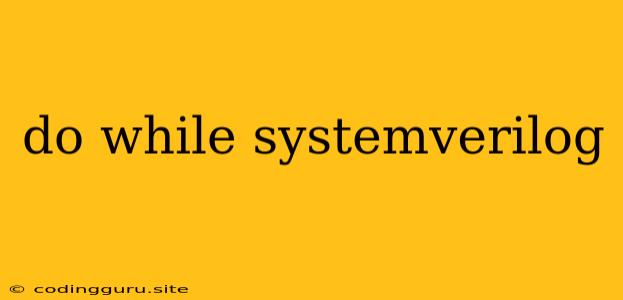Demystifying the do while Loop in SystemVerilog: A Comprehensive Guide
SystemVerilog, a powerful hardware description language (HDL), offers a rich set of constructs to model complex digital circuits. One such construct is the do while loop, which provides a convenient way to repeat a block of code until a certain condition is met.
But how does the do while loop work in SystemVerilog, and when should you use it? Let's delve into the details and unravel the intricacies of this powerful loop structure.
What is a do while Loop in SystemVerilog?
The do while loop in SystemVerilog is a repetitive control flow statement that executes a block of code at least once and then repeatedly checks a specified condition after each iteration. If the condition evaluates to true, the loop continues to execute. Otherwise, the loop terminates and the program flow moves to the next statement after the loop.
The Structure of a do while Loop
The syntax of a do while loop in SystemVerilog is straightforward:
do
// Code to be executed repeatedly
while (condition);
Here's a breakdown:
do: This keyword marks the beginning of the loop.// Code to be executed repeatedly: This is the block of code that will be executed for each iteration of the loop.while (condition): This is the loop condition. The code within the loop will execute as long as this condition remainstrue.
Understanding the Flow of Execution
The do while loop in SystemVerilog works as follows:
- Initialization: The program counter enters the loop at the
dokeyword. - Code Execution: The code within the loop block is executed once.
- Condition Check: After executing the code, the loop condition is evaluated.
- Iteration Decision:
- If the condition is
true, the program counter jumps back to the beginning of the loop (thedokeyword), and the loop executes again. - If the condition is
false, the program counter moves to the next statement after thewhilestatement.
- If the condition is
Why Use a do while Loop?
The do while loop is a valuable tool in SystemVerilog for several reasons:
- Guaranteed Execution: The
do whileloop ensures that the code within the loop is executed at least once, regardless of the initial value of the loop condition. This makes it ideal for scenarios where you need to perform an initial action before checking a condition. - Flexibility: Unlike a
forloop, thedo whileloop allows you to dynamically control the number of iterations based on the condition. - Debugging:
do whileloops can be used for debugging purposes. You can use a$displaystatement within the loop to print the values of variables and track the execution flow.
Practical Examples
1. Counting with a do while Loop
integer count = 0;
do begin
$display("Count:", count);
count = count + 1;
end while (count < 10);
This code will display the value of count from 0 to 9. It demonstrates how the loop iterates until the condition count < 10 becomes false.
2. Simulating a Counter with a Reset
integer count = 0;
logic reset = 1'b1;
// Initialize the counter
do begin
$display("Resetting counter...");
count = 0;
reset = 1'b0;
end while (reset);
// Count up until a specified value
do begin
$display("Count:", count);
count = count + 1;
end while (count < 10);
This example showcases how the do while loop can handle complex scenarios. Initially, the reset signal is set to 1, causing the loop to execute and reset the counter. Once the reset signal becomes 0, the loop terminates and the counter starts counting up.
Important Considerations
- Infinite Loops: Be cautious about infinite loops. If the condition in a
do whileloop never becomes false, the loop will run indefinitely. - Clarity and Readability: While
do whileloops offer flexibility, ensure your code remains clear and readable. Use comments and proper indentation to help others understand your logic.
Conclusion
The do while loop is an essential tool in SystemVerilog, offering a flexible and powerful way to control code execution. By understanding its workings and using it judiciously, you can design and implement efficient and robust hardware designs. Remember to think carefully about the loop condition, potential infinite loops, and code clarity to ensure optimal performance.
